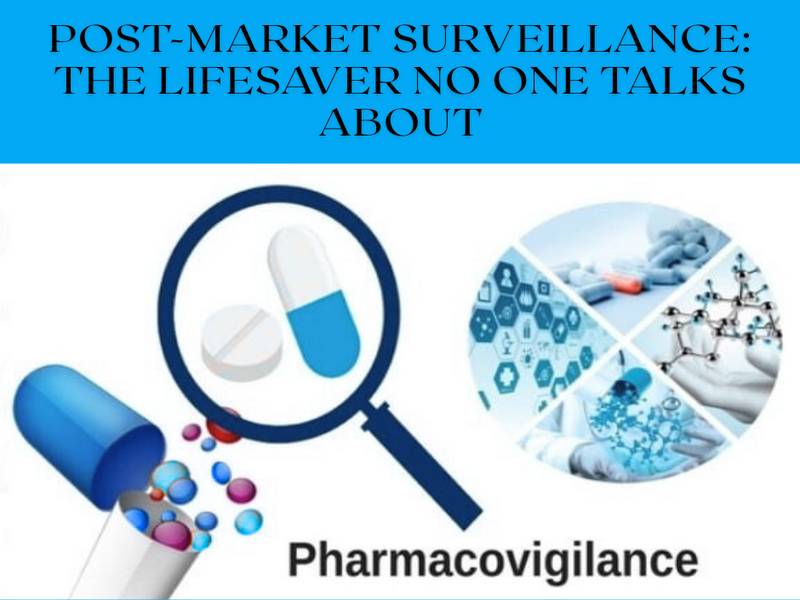We often focus on clinical trials when thinking about the safety and effectiveness of medicines and devices. But what happens after a product is approved and widely used? That’s where Post-Market Surveillance (PMS) comes in—a vital but often overlooked process that ensures ongoing safety and effectiveness.
What is Post-Market Surveillance?
Post-market surveillance is a continuous process of monitoring the safety, effectiveness, and overall performance of drugs and medical devices after they’ve been approved for public use.
While clinical trials provide invaluable data, they have limitations – involving a controlled environment and a relatively small group of participants making it difficult to identify all potential risks.
Post-market surveillance, on the other hand, gathers real-world data from the millions of people actually using these products, allowing regulators and manufacturers to uncover any long-term effects or rare side effects that might have been overlooked in trials.
By monitoring products in the real world, PMS acts as a safety net, enabling authorities to detect issues early and take swift corrective actions—whether that’s issuing safety warnings, changing product labels, or in some cases, withdrawing a product entirely.
Types of Post-Market Surveillance:
1. Active PMS: Involves evaluating feedback from stakeholders, investigating market complaints, assessing product quality issues, and taking regulatory action as necessary.
2.Proactive PMS: Involves systematic, scientific surveys of product quality, conducted according to protocols developed by the Pharmacovigilance/Post-Market Surveillance Technical Working Group.
The Key Components of Post-Market Surveillance:
While Post-Authorization Safety Studies (PASS) and Post-Authorization Efficacy Studies (PAES) are two main aspects of PMS, they’re just the tip of the iceberg.
Post-market surveillance also includes:
1. Adverse event reporting
2. Risk Management Plans (RMPs)
3. Periodic Safety Update Reports (PSURs)
4. Signal detection
5. Labeling updates
6. Data from observational studies
7 . Post-marketing clinical trials
Collectively, they create a continuous exchange of information between regulators, manufacturers, healthcare providers, and the public, all working together to safeguard the health and well-being of individuals everywhere.
PASS vs PAES: What’s the Difference?
The two key elements of post-market surveillance are PASS (Post-Authorization Safety Studies) and PAES (Post-Authorization Efficacy Studies). While both are crucial, they serve distinct purposes:
- PASS focuses on safety. These studies monitor the potential side effects or long-term risks that might not have appeared during clinical trials. They help identify issues such as rare side effects or drug interactions that could pose a risk to the broader population.
- PAES, on the other hand, centres on efficacy. These studies ensure that a product continues to perform as expected across various populations and under real-world conditions. PAES helps confirm that the drug or device remains effective in diverse patient groups—those with coexisting health conditions, for example—that weren’t fully represented in clinical trials.
While PASS aims to ensure a drug’s safety, PAES ensures that it continues to deliver the therapeutic benefits it was designed to provide. Both are vital in making sure the products we use are safe, effective and deliver the results we expect.
Benefits of Post-Market Surveillance:
- Real-World Monitoring: Unlike clinical trials, which often involve controlled environments and small sample sizes, PMS tracks how products perform in a much larger and more diverse population. This provides valuable insights into how a product works in real-life settings, over extended periods.
- Identifying New Risks: Even with thorough pre-market testing, new risks may arise once a product is released to the public. PMS is essential for detecting these emerging risks, such as unexpected side effects or long-term health impacts that weren’t visible in clinical trials.
- Improving Product Quality: If any quality issues arise after a product reaches the market, PMS helps companies quickly address and resolve them. For instance, if a medical device has a manufacturing defect, PMS can prompt recalls or corrective actions to prevent harm and ensure consumer safety.
- Ensuring Ongoing Efficacy: Over time, products may face declines in efficacy or encounter new performance challenges. Continuous monitoring through PMS ensures that marketed products consistently meet safety and efficacy standards, even as they are used in various real-world conditions.
The Role of Consumers and Healthcare Providers In Post Marketing Surveillance.
Post-market surveillance isn’t just the responsibility of regulatory agencies and manufacturers—it’s also up to us, the consumers, and the healthcare providers who prescribe and monitor these products.
Reporting adverse events or product issues is essential for helping authorities and companies identify and respond to problems.
For consumers, staying informed about the products they use—and knowing how to report any adverse effects—is vital.
Healthcare providers also have a key role in monitoring and reporting adverse events, ensuring that patients receive the best care possible while minimizing the risks associated with medications or medical devices.
Conclusion: A Lifelong Commitment to Safety
Post-market surveillance is not just an afterthought—it’s a lifelong commitment to ensuring product safety.
It plays a vital role in protecting public health by continuously monitoring the safety and effectiveness of drugs and devices. This ongoing oversight ensures that the standards set during a product’s development are maintained and that any emerging risks are quickly addressed.
By identifying new risks, enhancing product quality, and ensuring long-term efficacy, post-market surveillance guarantees that products continue to deliver the benefits they were designed to provide.
As Jeyflex Consultants, we are committed to supporting post-marketing surveillance (PMS) to ensure the continued safety and efficacy of products.
We provide specialised PMS services such as adverse event monitoring, regulatory reporting, and signal detection. Our solutions help manufacturers, healthcare providers, and consumers stay informed and respond swiftly to emerging risks, protecting public health.
Contact us today to learn more about how our PMS services can help you monitor and manage the safety of your products. Let’s work together to ensure that the products you rely on remain safe and effective.
Let’s Discuss!
What do you think? Which component of Post-Market Surveillance do you believe is most critical to protecting public health? And how do you think we could improve PMS to make it even more effective in the real world?
Join the conversation and share your thoughts with us! Use the hashtag #PostMarketSurveillance and let’s continue to explore how we can all contribute to a safer healthcare system.
Article by Brenda Mwiti




